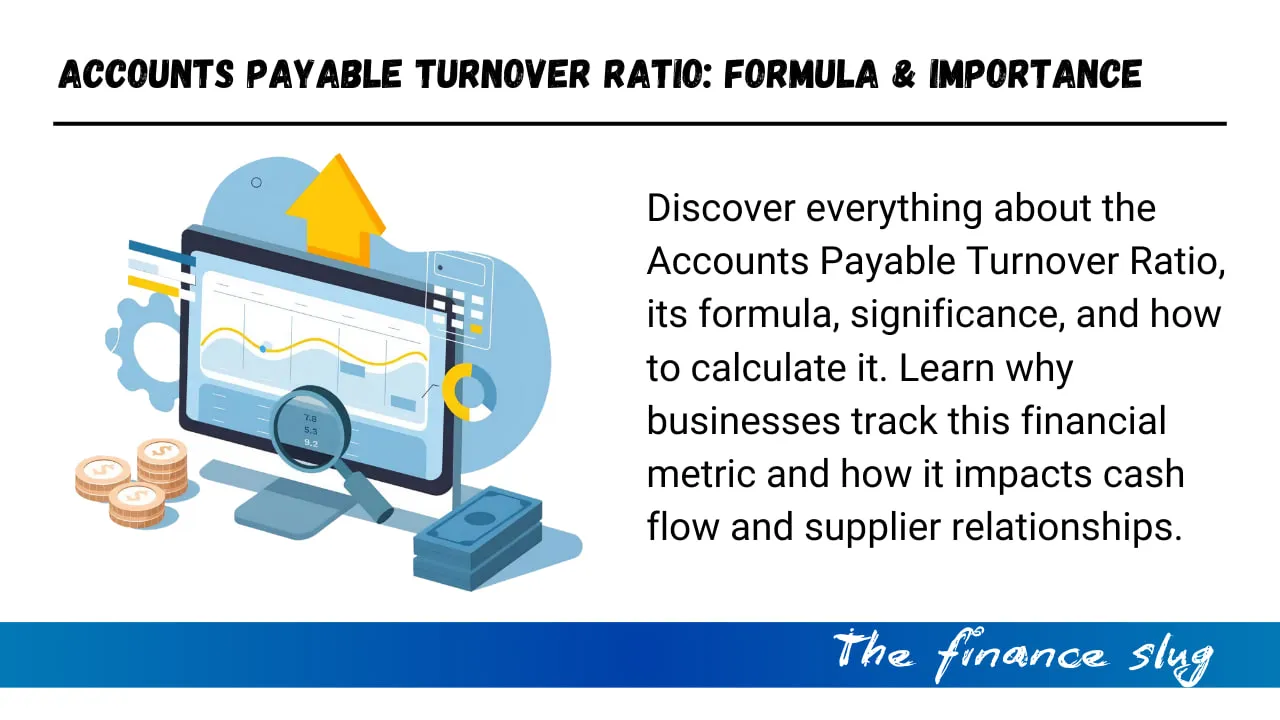
- What is the Accounts Payable Turnover Ratio?
- Formula for Accounts Payable Turnover Ratio
- Why is the Accounts Payable Turnover Ratio Important?
- How to Calculate the Accounts Payable Turnover Ratio (Example)
- What is a Good Accounts Payable Turnover Ratio?
- How to Improve the Accounts Payable Turnover Ratio
- Accounts Payable Turnover Ratio vs. Accounts Receivable Turnover Ratio
- Common Mistakes When Interpreting AP Turnover Ratio
- Final Thoughts
- Frequently Asked Questions (FAQs)
What is the Accounts Payable Turnover Ratio?
The Accounts Payable Turnover Ratio (APTR) is a financial metric that measures how often a company pays its suppliers within a given period. It indicates a business’s efficiency in managing its accounts payable and supplier obligations. A higher ratio suggests that a company pays its suppliers quickly, whereas a lower ratio may indicate delayed payments or cash flow issues.
This ratio is a crucial indicator of financial stability, supplier relationships, and overall business efficiency. It helps stakeholders assess how well a company manages its short-term liabilities and cash flow.
Formula for Accounts Payable Turnover Ratio
The formula for calculating the Accounts Payable Turnover Ratio is: Accounts Payable Turnover Ratio=Total Supplier Purchases (or Cost of Goods Sold)/Average Accounts Payable
Where:
- Total Supplier Purchases (COGS): The total amount a company spends on purchasing goods or services from suppliers.
- Average Accounts Payable: The average of beginning and ending accounts payable for a specific period, calculated as: Average Accounts Payable=(Beginning Accounts Payable+Ending Accounts Payable)/2
This ratio is usually measured on an annual, quarterly, or monthly basis to evaluate a company’s financial health.
Why is the Accounts Payable Turnover Ratio Important?
The Accounts Payable Turnover Ratio is essential for several reasons:
1. Evaluates Payment Efficiency
A high turnover ratio suggests that a company pays suppliers promptly, which may lead to better supplier relationships and improved credit terms.
2. Indicates Financial Stability
A steady or increasing AP turnover ratio reflects strong financial management, whereas a declining ratio could indicate cash flow struggles.
3. Impacts Supplier Relations
Companies with a high AP turnover ratio often enjoy better credit terms, discounts, and preferential treatment from suppliers.
4. Affects Cash Flow Management
By analyzing this ratio, businesses can optimize cash flow strategies and determine whether they should adjust their payment schedules to balance liquidity and vendor obligations.
How to Calculate the Accounts Payable Turnover Ratio (Example)
Step-by-Step Calculation
Example:
A company reports the following data for the year:
- Cost of Goods Sold (COGS): $500,000
- Beginning Accounts Payable: $50,000
- Ending Accounts Payable: $70,000
Step 1: Calculate Average Accounts Payable
Average AP=(50,000+70,000)/2=60,000
Step 2: Apply the Formula
AP Turnover Ratio=500,000/60,000=8.33
Interpretation
This means the company pays off its accounts payable 8.33 times per year. A higher ratio indicates prompt payments, whereas a lower ratio suggests delayed payments or potential cash flow issues.
What is a Good Accounts Payable Turnover Ratio?
There is no universal “ideal” AP turnover ratio, as it varies by industry, company size, and business model. However, general benchmarks include:
- High Ratio (10+): Strong financial health, quick supplier payments, and efficient cash flow management.
- Moderate Ratio (5-10): Balanced approach, where payments are made on time without straining cash reserves.
- Low Ratio (<5): Delayed payments, possible liquidity issues, or strategic use of extended payment terms.
A company must compare its ratio with industry averages and historical trends to determine optimal performance.
How to Improve the Accounts Payable Turnover Ratio
Improving your AP Turnover Ratio can enhance cash flow and supplier relationships. Here’s how:
1. Negotiate Better Payment Terms
Request longer payment terms (e.g., Net 60 instead of Net 30) to maintain liquidity without straining relationships.
2. Streamline Invoice Processing
Use automated accounting software to process invoices faster, avoid errors, and ensure timely payments.
3. Improve Cash Flow Management
Monitor cash inflows and outflows closely to ensure supplier payments align with revenue generation.
4. Leverage Early Payment Discounts
Some suppliers offer discounts for early payments, which can reduce overall expenses.
5. Monitor Supplier Performance
Assess whether certain suppliers cause bottlenecks in your operations and consider alternative vendors if necessary.
Accounts Payable Turnover Ratio vs. Accounts Receivable Turnover Ratio
The Accounts Payable Turnover Ratio and Accounts Receivable Turnover Ratio are related but measure different aspects of financial performance:
| Metric | Measures | High Ratio | Low Ratio |
|---|---|---|---|
| Accounts Payable Turnover Ratio | How often a company pays its suppliers | Pays suppliers quickly | Delayed payments, possible cash flow issues |
| Accounts Receivable Turnover Ratio | How often a company collects payments from customers | Collects payments efficiently | Slow collections, potential bad debts |
Both ratios provide insights into a company’s liquidity and working capital management.
Common Mistakes When Interpreting AP Turnover Ratio
1. Ignoring Industry Standards
A ratio of 5 might be low for a tech company but average for a construction firm. Always compare with industry benchmarks.
2. Overlooking Seasonal Variations
Businesses with seasonal sales (e.g., retail) may see fluctuating AP turnover ratios throughout the year.
3. Misinterpreting a High Ratio
A very high AP turnover ratio isn’t always positive—it could indicate missed opportunities for cash flow optimization.
Final Thoughts
The Accounts Payable Turnover Ratio is a critical financial metric that helps businesses understand how efficiently they manage supplier payments. A balanced approach ensures strong supplier relationships while optimizing cash flow.
By analyzing and improving this ratio, companies can enhance financial stability and maintain a competitive edge in their industry.
Also Read : What is an Accounting Standard? Definition, Importance & Types
Frequently Asked Questions (FAQs)
1. What is considered a good AP turnover ratio?
A good ratio depends on the industry, but generally, 5-10 is considered a healthy range for most businesses.
2. How can I improve my AP turnover ratio?
You can improve it by negotiating better terms, automating invoice processing, leveraging early payment discounts, and managing cash flow efficiently.
3. Can a high AP turnover ratio be a bad sign?
Yes, an excessively high ratio might mean a company isn’t fully utilizing its available credit terms, potentially straining cash reserves.
4. How does AP turnover ratio impact supplier relationships?
A higher ratio indicates faster payments, which can lead to better supplier relationships and favorable terms.
5. What is the difference between AP turnover and AR turnover?
AP turnover measures how often you pay suppliers, while AR turnover measures how often you collect payments from customers.
Stock Market Crash Today: A Bloodbath on Monday – What You Need to Know
Published on financeslug.xyz The global financial markets are reeling from a massive sell-off, and Indian…
Wall Street Bonuses Reach Record $47.5 Billion in 2024, Up 34% from Previous Year
How to Convert Delimited CSV Data into Columns in Excel
CSV (Comma-Separated Values) files are widely used for data exchange, but when opened in Excel,…
Harvard University Announces Free Tuition for Families Earning $200K or Less
Harvard’s New Tuition-Free Policy: What You Need to Know Harvard University has unveiled a groundbreaking…
Eli Lilly’s 1.8B Dollar Investment in Weight Loss Drugs
Ireland’s Weight-Loss Drug Boom: A Game-Changer for Economy and Healthcare Ireland is witnessing a surge…
Forever 21 Files for Bankruptcy Again: The End of an Era in Fast Fashion?
Forever 21, once a staple in American malls and a leader in the fast-fashion industry,…







